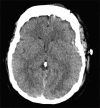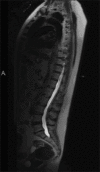Intracranial hypotension as a complication of lumbar puncture prior to elective aneurysm clipping
- PMID: 25324976
- PMCID: PMC4199149
- DOI: 10.4103/2152-7806.141751
Intracranial hypotension as a complication of lumbar puncture prior to elective aneurysm clipping
Abstract
Background: Lumbar dural defects are an uncommon but important cause of persistent intracranial hypotension in the neurosurgical population. We present a case of intracranial hypotension after elective craniotomy due to a lumbar puncture performed 3 weeks earlier.
Case description: A 55-year-old female underwent uneventful craniotomy for clipping of an unruptured left middle cerebral artery bifurcation aneurysm. Postoperatively, the patient showed a gaze deviation and failed to wake up. Computed tomography demonstrated significant postoperative pneumocephalus. Family members indicated that the patient underwent a lumbar puncture 3 weeks prior to surgery to rule out a subarachnoid hemorrhage. The excessive pneumocephalus was initially interpreted as a result of spinal cerebrospinal fluid leak, and the patient was placed in the Trendelenburg position. This positioning resulted in some improvement in her mental status, although she was unable to tolerate any subsequent elevation in the head of her bed. Magnetic resonance imaging analysis of her spinal axis did not demonstrate any evidence of cerebrospinal fluid leak, but a subsequent lumbar blood patch resulted in rapid and dramatic improvement in the patient's status. She was subsequently discharged after an uneventful hospital stay.
Conclusion: Although uncommon, persistent intracranial hypotension caused by lumbar dural defects must be considered in patients who have recently undergone procedures that compromise the lumbar dura because prompt intervention can significantly improve the patient's condition.
Keywords: Defect; intracranial hypotension; lumbar dura; lumbar puncture; tension pneumocephalus.
Figures



Similar articles
-
Tension pneumocephalus as a complication of lumbar drainage for cerebral aneurysm surgery--case report.Neurol Med Chir (Tokyo). 2009 Jun;49(6):252-4. doi: 10.2176/nmc.49.252. Neurol Med Chir (Tokyo). 2009. PMID: 19556734
-
Spontaneous spinal cerebrospinal fluid leak as a cause of coma after craniotomy for clipping of an unruptured intracranial aneurysm.J Neurosurg. 2009 Mar;110(3):521-4. doi: 10.3171/2008.9.JNS08670. J Neurosurg. 2009. PMID: 19012477
-
Iatrogenic Development of Cerebrospinal Fluid Leakage in Diagnosing Spontaneous Intracranial Hypotension.Korean J Fam Med. 2018 Mar;39(2):122-125. doi: 10.4082/kjfm.2018.39.2.122. Epub 2018 Mar 22. Korean J Fam Med. 2018. PMID: 29629045 Free PMC article.
-
[Post-lumbar puncture syndrome--its pathogenesis, prophylaxis and treatment].Neurol Neurochir Pol. 2006 Sep-Oct;40(5):434-40. Neurol Neurochir Pol. 2006. PMID: 17103357 Review. Polish.
-
An unusual fatal complication of low basilar trunk aneurysm surgery: isolated prepontine tension pneumocephalus.Surg Neurol. 1999 Nov;52(5):485-9. doi: 10.1016/s0090-3019(99)00040-3. Surg Neurol. 1999. PMID: 10595769 Review.
Cited by
-
Lumbar epidural blood patch: An effective treatment for intracranial hypotension.Surg Neurol Int. 2022 Nov 11;13:517. doi: 10.25259/SNI_795_2022. eCollection 2022. Surg Neurol Int. 2022. PMID: 36447895 Free PMC article.
References
-
- Bezov D, Ashina S, Lipton R. Post-dural puncture headache: Part II--prevention, management, and prognosis. Headache. 2010;50:1482–98. - PubMed
-
- Burns J, Scheinfeld MH. Back to the scanner: Expected and unexpected imaging findings following spinal puncture and access. Emerg Radiol. 2013;20:291–7. - PubMed
-
- Cain RB, Patel NP, Hoxworth JM, Lal D. Abducens palsy after lumbar drain placement: A rare complication in endoscopic skull base surgery. Laryngoscope. 2013;123:2633–8. - PubMed
-
- Han IB, Ropper AE, Teng YD, Ryoo YH, Kim O. Bladder and bowel dysfunction following small-volume epidural blood patch for spontaneous intracranial hypotension. J Clin Neurosci. 2013;20:325–8. - PubMed
Publication types
LinkOut - more resources
Full Text Sources
Other Literature Sources
